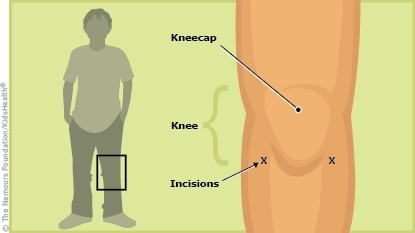Arthroscopy is done by orthopedic surgeons (bone doctors). They make small incisions (cuts) and use an arthroscope (a thin tube with a tiny camera attached) and tiny instruments to diagnose and repair some types of joint problems. Using arthroscopy (ar-THRAH-skeh-pee) instead of regular surgery (where the incision is bigger) helps your child have less pain, a faster recovery, and a lower risk of infection after the surgery.

Follow your surgeon's instructions for:
- Giving your child any medicines for pain. This may include acetaminophen (Tylenol® or a store brand), ibuprofen (Advil®, Motrin®, or a store brand), or prescription pain medicine. Some prescription pain medicines include the same or similar ingredients as those you can buy without a prescription. To avoid your child getting too much, give the medicines exactly as your surgeon recommends.
- When to remove any adhesive strips and the elastic bandage.
- How to clean the area.
- When your child can put weight on the leg.
- What exercises and movements to do.
- Whether your child needs to go to physical therapy (PT).
- How to use the crutches and when your child can stop using them.
- Whether your child needs to wear a brace or other supportive device during recovery and after they heal.
- What activities your child needs to avoid and when they can expect to go back to full activity and sports.
- When your child can drive. This is usually at least 1–3 weeks after surgery.
- When it's OK for your child to take a shower (this is usually 2–3 days after surgery) and if your child needs to cover the incisions during showers. Avoid putting the knee fully under water (for example, in a bath or pool) until the surgeon says it's OK.
- When to have a follow-up visit.
For the first few days after the surgery:
- Use pillows to raise the knee above heart level when your child is sitting or lying down.
- When your child is awake, put a cold pack or plastic bag of ice wrapped in a towel on the knee bandage for 20 minutes every 3 hours. Don't put ice directly on the skin or bandage.
- If your child's knee is swollen or feels tingly or numb, loosen the elastic bandage slightly and raise the knee above heart level.

What knee problems can arthroscopy treat? Most knee problems are first treated with rest, physical therapy, and medicines. If those don't work, sometimes knee arthroscopy is recommended. Surgeons can use knee arthroscopy to diagnose or treat:
- a torn meniscus (tissue in the knee that cushions the joint)
- torn ligaments (bands of tissue that connect bones to other bones)
- torn tendons (bands of tissue that connect muscles to bones)
- a chipped bone
- a joint infection




